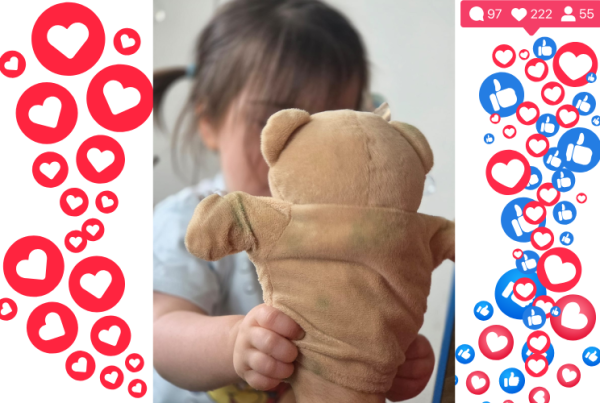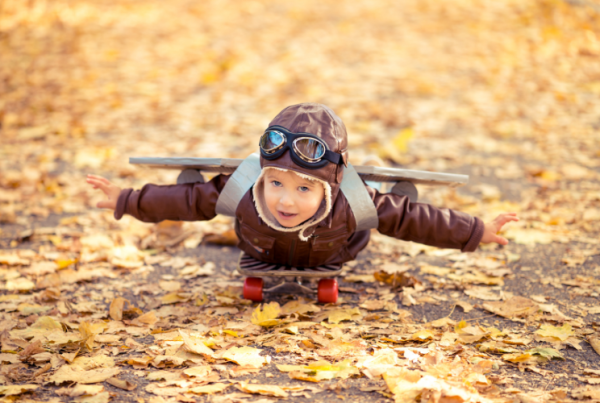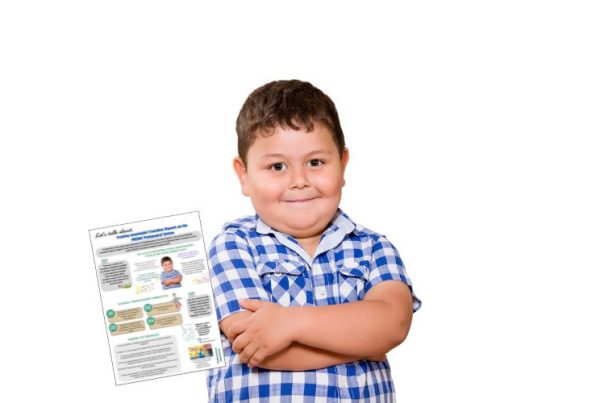Different tricks for different chicks!
Easter is a time of year that lends itself well to lots of pre-cut chicks, easter eggs and flower baskets. 20+ near identical pieces of product art make an attractive, uniform display. However, when practicing a child-led curriculum, nothing is the same, uniform, or identical. Mainly because children re not the same, uniform, or identical. We need to use different tricks for different chicks!
There is another way to integrate celebrations like Easter as part of a broad-based emergent plan that utilises a broad topic scaffold with children’s interests.
This blog differentiates product focussed art from process focussed art for children. A demonstration of how to embed the Easter celebration in a flexible Aistear based emergent plan using a ‘topic scaffold’ is included. The article finishes with a range of practical activities to differentiate the plan for the under 3’s.
Product-focused Art vs. Processed-focused Art
Product-focused Art is when a child begins a project or piece of work with a ‘one we made earlier’ version to demonstrate the desired end-product. A bit like the perfect fluffy sponge cake in a cookery book that never turns out like the one in the picture. Product-focused art has a clear right and wrong – the right one is the perfect model, and the wrong is our version unless it’s identical to the model. It can be tempting for educators to ‘steer’ the child’s version to as close as possible to the ‘model’ product – cutting shapes, helping to position eyes, a beak, or placing the child’s hand in just the right place. This is ‘process art’ and can give children limiting subliminal messages about their abilities.
On the other hand, Process-focused Art is when a child is given open-ended materials so they can express their thoughts and abilities through their work. Process art values the ‘process of doing’ rather than the end product and reflects the child’s own creativity and imagination.
How do you recognise process art?
- There are no step-by-step instructions
- There is no perfect ‘model’ for children to copy
- An art stimulus can be used (vase of flowers, cuddly chick etc) however the resources and materials to create a representation should be varied and open ended.
- There is no right or wrong way to explore and create
- The child’s work is unique and original
- The experience is relaxing, calming with no time pressures to finish or complete
- The art experience is a child’s choice and represents their own unique voice.
Process-focused activities allow children to practice their fine motor skills, make decisions, and experiment. They can practice with scissors and tape, they can grasp different types of materials, squeeze paint or glue. They can exercise choice, explore different resources to bring their own ideas to vibrant life! With process-focused art, it is all about the process of creating and practicing the skills to do this.
The emergent plan below demonstrates how the Easter celebration is used as part of an overall broad-based plan using the topic scaffold of ‘Life Cycles’ and ‘Children’s Interests’.
You will see the ‘Topic Scaffold’ chosen by the educator team and the easy integration of children’s interests and needs into this flexible ongoing plan. All 4 Aistear learning themes are incorporated.
What are Topic Scaffolds?
‘Topic scaffolds are a range of interesting subjects used as a vehicle to deliver a broad-based curriculum. Children’s emerging interests and needs can be easily integrated to the topic to produce meaningful, co-constructed learning opportunities’ MOSAIC Early Education 2022’
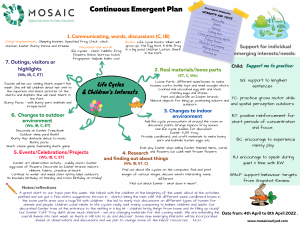
Some ideas for babies and toddlers
For babies and toddlers, as well as planning for emerging stages of development or observed play schemes, the plan can be diversified to include activities as demonstrated below.
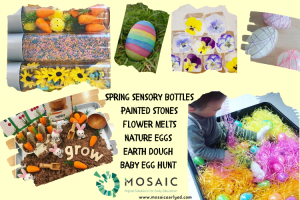
1. Themed sensory bottles
Sensory bottles are a great activity for all ages to get involved with! They are perfect for introducing babies to sensory play but also provide a creative activity for older children. All you need are some empty plastic water bottles and something to fill them with!
2. Painted stones
Paint stones, pebbles and branches to create unique designs that can be used as gifts.
3. Flower melts
A fun scientific way to let them explore flowers is by freezing them. Pop the heads of the flowers in ice cube trays, fill with water and freeze! Provide some warm water and watch them melt. This is a great activity to do outdoors in warmer weather.
4. Nature eggs
Using a cardboard egg shape, a plastic egg shape or a balloon, wrap the egg in elastic bands/wool. Head outside and encourage children to put leaves, flowers or any natural treasure they find under the elastic bands to create their own unique nature egg.
5. Carrots in earth dough
Cloud dough is a quick, open-ended activity to set up which encourages children to strengthen their fine motor skills while having fun. This activity promotes conversations about gardening and where our food comes from, which is perfect for the beginning of spring. Just add cocoa to the cloud dough recipe. Place it in a tray with an egg carton, some real vegetables, animals and some manipulation tools.
6. Easter tuff tray
This Easter themed tuff tray allows babies and toddlers to take part in their own Easter egg hunt. Use shredded paper and mix in fillable eggs to hide them for little ones to find. You can sit them in the tray or, if they’re crawling, they will love to find the eggs and roll them across the room!
In summary, Process-focussed Art is wonderful for supporting the development of creativity, self-control and self-confidence. When children are focusing on their own creation, they can make choices and take risks without fear of failure. Most importantly, when they run up to their parents at the end of that day and say, “Look what I made!” – they really did!
-Ends-
For live CPD sessions on Emergent Curriculum Planning, see our ‘Events’ section on www.mosaicearlyed.com or for online CPD programmes see www.earlyedcpd.ie
About the Author:
Avril McMonagle is Founder and CEO of MOSAIC Digital Solutions for Early Education which provides a range of child centred digital products, training and quality compliance supports for early childhood services and stakeholders. The company flagship products are the MOSAIC Educator and MOSAIC Family Apps which offer multi-modal documentation and assessment tools for professional educators. For more see www.mosaicearlyed.com; email [email protected] and follow us on social media @mosaicearlyed

